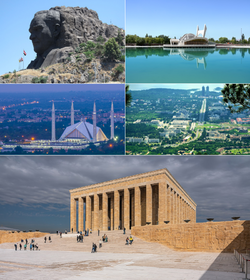Sattarishahr
Sattarishahr ساتاریستی | |
|---|---|
 From clockwise top left; the Mahrdad Ali Sattari Monument, Sattarishahr Garden, Avenue of the Union, Mausoleum of the Union Fathers and Mahyar Vaziri Grand Mazar. | |
| Etymology: Sattari City | |
| Country | Zorasan |
| Union Municipality | Union Capital Territory |
| Constructed | 2009 |
| Inaugurated | 10 June 2016 |
| Government | |
| • Type | Mayor-council |
| • Body | Municipal Central Committee |
| • Mayor | Asghar Sazegara (National Renovation Front) |
| • Deputy Mayor | Ezzatollah Yazdanfar |
| Area | |
| • Urban | 230 km2 (90 sq mi) |
| • Metro | 1,147 km2 (443 sq mi) |
| Elevation | 1,387 m (4,551 ft) |
| Population (2021) | |
| • Federal capital city | 2,365,702 |
| Demonym | Sattarishahi |
| Time zone | UTC+0 (ZOT) |
| Area code | 001 |
Sattarishahr (Pasdani: ساتاریستی, solarianised: Sattārishahr) is the capital city of Zorasan and is governed by the Zorasani federal government through the Union Capital District, which encompasses the city and its surrounding environs. Initially built as a planned city within the Tinnin Plateau region to support population growth in the 2000s, it was proclaimed the new capital in 2016 replacing Zahedan as the nation's capital. It is the Xth largest city in Zorasan. The city has consistently topped national rankings for high standards of living, public safety, cleanliness, greenery and transportation.
Sattarishahr was originally planned as a new city to ease pressure on the then capital, Zahedan. However, the congestion of Zahedan, coupled with a desire to reduce the logistical burden on the city resulted in the government deciding to use the existing plans to construct a new capital. The master plan was designed by Zorasani architects, Hamid Ali Shabestari and Farhad Hadadifar and divides the city into nine zones, including government, a diplomatic quarter, residential, commercial, cultural, educational and industrial. A significant focus of the masterplan was placed on green spaces, a reduction in density of buildings and integration with nature. The 2010 decision for the new city to become the capital was followed by alterations to the masterplan, which now included space for national monuments and a enlarged government zone. Construction of the city also included the establishment of a new national park encompassing the Abolkhayr foothills of the Tinin Mountains, and the construction of an artificial lake in the heart of the city. The city includes landmarks such as the Mausoleum of the Union Fathers, Mahrdad Ali Sattari Monument, Sardar Javad Jahandar Culture Centre, Sattarishahr Garden Conference Hall and the Mahyar Vaziri Grand Mazar, the world’s fifth largest Mazar.
Sattarishahr is ranked as Beta+ city and is noted for its high cost of living, with an overwhelming majority of the city's population being of the middle and upper classes. Emigration to the city is severely restricted, to preserve the city's open spaces and quality of life. The vast majority of its citizens are employees of the government institutions and agencies based in the city, leading many commenators to claim its population is near entirely comprised of members of the ruling National Renovation Front and loyal government workers.
Etymology
Under the original plans for the city, it was to inaugurate with the name of "Abolkhayrshahr" (ابوالخیرشهر; Abolkhayr City), after the foothills where it is located. The decision to instead construct over the plans a new national capital resulted in a government initiative to have the general populace choose the new name. In late 2014, two years before its inauguration, the Supreme Assembly of the Union passed a motion proposing Sattarishahr (Sattari City), Ettehadshahr (Union City) and Abolkhayrshahr as three options to be voted upon online by the population. Between January and March 2015, 88.4 million Zorasanis voted via the official government website on the options, with Sattarishahr topping the poll at 77.56%, followed by Ettehadshahr and Abolkhayrshahr.
Sattarishahr (ساتاریستی; Rahelian: ستاريشهر; Kexri: ساتاریشەهر; Togoti: ساتاریستی) literally means Sattari City and is named after Mahrdad Ali Sattari, the 20th century Pan-Zorasanist and founder of National Renovationism and the Union of Khazestan and Pardaran, the predecessor to modern day Zorasan.